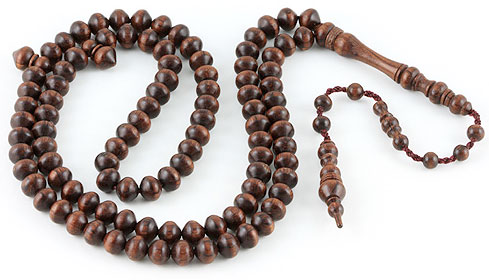Called subha, from the Arabic to praise, the Muslim rosary has 99 beads, one for each name of Allah found in the Koran. It is believed that whoever recites these 99 names—as well as the phrase Glory to Allah on the long bead known as the imam or leader bead—will get into heaven. The subha is strung with markers after the 33rd and 66th beads.
 |
|
 |
Islamic subha strung with 99 handmade beads, imam and tassel composed of Turkish rosewood. Vessel-shaped markers are strung after the 33rd and 66th beads. |
All kinds of stones are used in the making of these prayer beads, but the most beloved, says Lois Sherr Dubin in her book, The History of Beads: From 100,000 B.C. to the Present, are from date pits that come from the sacred pilgrimage city of Mecca. Prayer beads are typically sold near places of worship, and Islamic subhas are no exception. You'll find vendors stationed outside mosques.
Dharma Beads: Making and Using Your Own Buddhist Malas
Joanna Arettam (2000) Journey Editions; Tuttle Publishing

